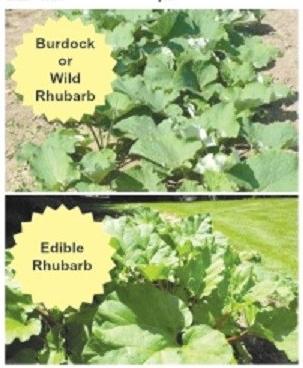Published in the Cannon Falls Beacon, 20June2018.
If you’re a fan of the tart flavor of the rhubarb fruit commonly found in the grocery stores in the early to mid-summer months, you may feel delighted when you happen upon a rhubarb plant growing out on the edges of a farmer’s field or in the bushes along the Cannon bike trail.
But take heed, enthusiastic forager! The plant you see is likely not what you think.
Rhubarb is technically a vegetable, but it’s green- to red-hued stalks are treated more like fruit when it’s cooked to make desserts or chewed raw as a tart garden snack. However, an invasive species of broadleaf weed, more commonly known as burdock, also goes by another name: wild rhubarb. It has several features in common with the edible rhubarb plant we all love but, unlike its lookalike, the stalks of the burdock are not considered edible in the common sense (though the plant can be eaten and is frequently used medicinally).
The most distinguishing and immediately noticeable feature of both edible rhubarb and wild rhubarb (burdock) are the broad, fanning, gently ruffled, bright green leaves. The key visual differences are these: the veins of edible rhubarb leaves are red, like its fruit, and thicker than the green, thin veins of the burdock; and rhubarb’s leaves are smooth and glossy while burdock leaves are matte and have a slightly velvety underside.
The key ingestible difference between the plants’ leaves is very important: Burdock leaf is safe to consume but rhubarb leaf is poisonous and ingesting them can cause respiratory failure or even coma as a result of the oxalic acid in them. (Forager’s Note: As always, do not consume any part of any plant until you are completely certain of that plant’s identification!)

Photocopy of images provided on the original June 20, 2018 printing of “The Local Wild” depicting burdock (wild rhubarb) versus edible rhubarb.
An even closer look and a little time will show that burdock leaves actually stem from, well, a stem, while rhubarb stalks jut out of from rhizomes, or a rootstalk, underneath a broader area of ground. Just remember this: Burdock grows up; rhubarb grows out.
And up is no joke! At its maturation, burdock can reach heights of six feet and their various stems are tipped by the burdock’s characteristic seed, the burr, which adheres so well to almost anything – even leather – that its design was replicated and used as the blueprint for the hook and loop fasteners that go by the generic name Velcro.
Beyond the leaves and height, the stalks (also called stems) of the two plants are nearly indistinguishable to the untrained eye. Because even stalks of ripe edible rhubarb can be bright green as well as deep red, the stalks of burdock are easy to misinterpret since they start as a deep, straight-veined pink or red at the base and fade in a gradual gradient to the same bright green color of the leaves. Side by side, stalks of “immature” or green rhubarb and burdock are hard to tell apart.
A simple taste of the stalk will tell you if you’ve found edible rhubarb or not. Burdock will have a distinctive, slightly bitter vegetable flavor that some foragers compare to raw artichoke; rhubarb will simply taste like rhubarb! And, not to worry: The stalks of burdock are safe to consume, even if they don’t have the best flavor when you cook them up for a pie.
Note: I didn’t take any photos for this initial column, though the Beacon’s editor ended up publishing the piece with the photos shown. In all later columns I’ve submitted original photos with the article text.
